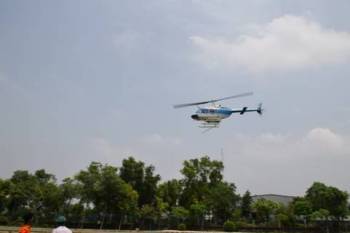NEW DELHI, 1 July 2020: Indian agriculture and farmers’ welfare minister Narendra Singh Tomar flagged off a helicopter with spray equipment from a helipad facility at Gautam Buddh Nagar, Greater Noida, Uttar Pradesh.
The helicopter will fly for Air Force Station at Uttarlai, Barmer where it will be stationed initially and from there deployed for locust control in desert areas of Barmer, Jaisalmer, Bikaner, Jodhpur and Nagaur.
The Bell 206-B3 helicopter will have single pilot operation, has a pesticide carrying capacity of 250 litres in one trip and can cover about 25 to 50 hectare area in one flight.
An Empowered Committee finalized the firm for deploying one helicopter for aerial spray in desert area after getting all the clearances from DGCA and Ministry of Civil Aviation.
Later, interacting with the media, Narendra Singh Tomar said that after a long gap of 26 years, last year locust attack took place. It was estimated that this year there would be greater locust problem, but Government is in full preparedness and all the State Governments have been alerted and are working in close coordination with the Centre.
Drones have been used for the first time for locust control
Deployment of machines, vehicles and manpower has been increased and concerned states are utilizing SDRF funds to tackle the problem.
Drones have been used for the first time for locust control and today aerial spraying of insecticides with the use of helicopter has also been launched.
He expressed gratitude to Ministry of Civil Aviation for enabling the deployment of drones and helicopter.
Tomar informed that order has been placed for 05 numbers of aerial spraying machines from a UK-based company, and once these are received, they will be deployed in IAF helicopters and pressed into operation for locust control.
Union Minister of State for Agriculture and Farmers’ Welfare Kailash Choudhary, Member of Parliament and former Union Minister Shri Mahesh Sharma, and Secretary, Agriculture Sanjay Agarwal were also present.
The deployment of the helicopter for locust control operations follows the need to strengthen air control capabilities for locust control through drones, helicopters and aircrafts.
Cabinet Secretary reviewed the locust situation on 27 May 2020
Cabinet Secretary reviewed the locust situation on 27 May 2020 and directed the Ministry of Civil Aviation to assist the Department of Agriculture Cooperation & Farmers’ Welfare in facilitating the procurement of goods and services for aerial spray of pesticides through drones, aircraft/helicopter.
Thereafter an inter-ministerial Empowered Committee under the chairmanship of the Additional Secretary, Agriculture was constituted for facilitating the procurement of goods and services for aerial spray of pesticides through drones, aircraft and helicopter. Officers of the MoCA, Pawan Hans, DGCA, Air India and DAC&FW are members of the committee.
On the recommendation of the Empowered Committee, for effective control of locusts settling on tall trees and inaccessible areas, DAC&FW engaged 5 companies to provide services of drones for locust control @ 5 drones per company.
Till now 12 drones have been deployed for locust control in Jaisalmer, Barmer, Jodhpur, Bikaner and Nagaur.
India becomes first country to use drones for locust control
India has become the first country in the world to use drones for locust control after finalizing the protocols. Use of Drones has added one additional dimension as it is effective for tall trees and inaccessible areas. One drone can cover 16-17 hectare area in one hour and in 4 hours it can cover upto 70 hectare area.
MoCA has further relaxed the terms and conditions of the conditional exemption granted for drone in anti-locust operations and permitted the use of engine-powered drones upto 50kg and use of drones during night times also for anti locust operations.
Presently major strategy of locust control is through 60 control teams with spray equipment mounted vehicles and more than 200 Central Government personnel are engaged in such operations in states of Rajasthan, Madhya Pradesh, Punjab, Gujarat, Maharashtra, Chhattisgarh, Haryana, Uttar Pradesh and Bihar. Locust Warning Organization (LWO) and ten Locust Circle Offices (LCOs) of Government of India are situated in Rajasthan (Jaisalmer, Bikaner, Phalodi, Barmer, Jalore, Churu, Nagaur, Suratgarh) and Gujarat (Palanpur and Bhuj), who primarily monitor, survey and control Desert Locust in two lakh square kilometer Scheduled Desert Area of Rajasthan and Gujarat.
For effective control of locust beyond Scheduled Desert Areas, temporary control camps of LCOs have been established in Jaipur, Ajmer in Rajasthan, Shivpur in Madhya Pradesh, Fazilka in Punjab and Jhansi in Uttar Pradesh.
State Governments undertake control operations deploying tractor mounted sprayers and fire tender vehicles. Starting from 11 April, 2020 till 28 June, 2020, control operations have been done in 2,33,487 hectares in States of Rajasthan, Madhya Pradesh, Punjab, Gujarat, Uttar Pradesh, Maharashtra Chhattisgarh, Haryana and Bihar.
No significant crop losses have been reported in the States of Gujarat, Uttar Pradesh, Madhya Pradesh, Maharashtra, Chhattisgarh, Bihar and Haryana. However, some minor crop losses have been reported in some districts of Rajasthan.
As per the Food and Agriculture Organization’s Locust Status Update of 27 June 2020, swarms that accumulate in northern Somalia are likely to migrate across the Indian Ocean to the summer breeding areas along the Indo-Pakistan border.
In Pakistan, swarms have already started laying eggs in Sindh and swarms are present in the Indus Valley. Virtual meetings of the technical officers of South West Asian countries (Afghanistan, India, Iran and Pakistan) have taken place on weekly basis. So far 15 SWAC-TOC meeting have been done this year. Technical information related to locust control in the region is being shared.




















